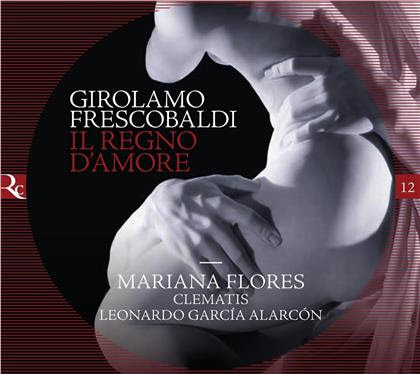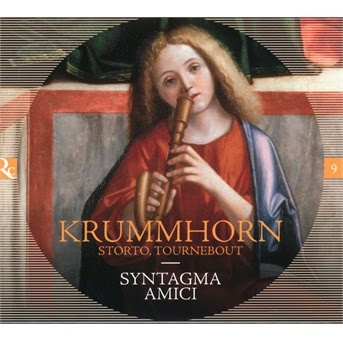Program: #20-43 Air Date: Oct 12, 2020
To listen to this show, you must first LOG IN. If you have already logged in, but you are still seeing this message, please SUBSCRIBE or UPGRADE your subscriber level today.
Music for krummhorn ensemble, secular songs by Frescobaldi, and the remarkable instrumental music of Carlo Farina.
I. Girolamo Frescobaldi: Il regno d’Amore (Mariana Flores, s./Clematis/Leonardo García Alarcón). Ricercar CD RIC 149.

Girolamo Frescobaldi was one of the most important and most influential composers of keyboard music of the early 17th century. He attracted many pupils from all over Europe, and in particular through his German pupil Johann Jacob Froberger he had a strong influence on the development of keyboard music throughout the continent. Far lesser known is the fact that he also composed music for instrumental ensemble and vocal works. Whereas his keyboard music was mainly written when he worked in Rome, his vocal works are the result of his stay in Florence.
In March 1628 Ferdinando II, Grand Duke of Tuscany, visited Rome, and in November of that year Frescobaldi was appointed as his organist. In reward Frescobaldi dedicated the collection of Canzoni in one to four parts and basso continuo to Ferdinando. While in Florence Frescobaldi also published two collections of Arie Musicali per cantarsi. The first book was dedicated again to the Grand Duke, the second to Marchese Roberto Obizzi, a nobleman from Ferrara - Frescobaldi's native city - who served as the duke's Master of the Horse.
It can't surprise that these vocal pieces were written during Frescobaldi's stay in Florence. This city was generally considered the birthplace of opera: Jacopo Peri, Giulio Caccini and Emilio de' Cavalieri all had been employed for some time by the Medici court in Florence. With them the stile nuovo was introduced, and much music in this style had been written and performed in Florence during the first decades of the 17th century. Frescobaldi's arias fit in with that tradition.
His vocal music has never been given much attention. The main reason is probably that his oeuvre is so much dominated by his keyboard music, and that this is of such quality and has had so much influence that it overshadowed all other parts of his output. Another reason could be the rather negative assessment of his vocal music by the theorist Giovanni Battista Doni (1595-1647), who told the French theorist Marin Mersenne that Frescobaldi didn't understand poetry and had to ask his wife to explain its meaning to him.
Whether that is true or not is impossible to verify. Listening to this disc of mainly vocal music I can't find any reason to ignore this part of his oeuvre. The fact that I am not that impressed with this disc hasn't much to do with the music but rather with the interpretation.
"The programme as a whole is organised into three sections similar to the three acts of a theatrical performance: Canti d'amor, Canti sacri, Ballo", according to the booklet. After a 'prologo', consisting of only one song, Se l'aura spira, a number of songs and instrumental pieces are performed. Some songs are strophic, and here Mariana Flores takes some rhythmic freedom in the form of rubato. But the application is too rigid and as the same trick is repeated time and again it becomes a bit stereotypical. Strangely enough in the non-strophic pieces, where the singer has naturally more rhythmic freedom, Ms Flores is too strict. Part of a stylistically satisfying performance is also the use of the messa di voce. Ms Flores understands that but only in Ohimé che fur its possibilities are fully explored. In most other pieces she is far too modest in this respect.
Even so I recommend this disc as there are not many recordings on the market with this kind of vocal pieces by Frescobaldi.
Johan van Veen
- Arie musicali Bk.1 No.15, Se l'aura spira, in 3 sections for solo voice
- In partitura, il primo libro della canzoni ... No.38, canto alto tenore, e basso, "Toccata per Spinettina, e Violino"
- Arie musicali Bk.1 No.17, Se m'amate io v'adoro, for 2 voices
- Arie musicali Bk.1 No.18, Begli occhi io non provo, song for 2 voices
- Il secondo libro de toccate, canzone...di cimbalo et organo, No.40, Partita Sopra Passacagli
- Arie musicali Bk.2 No.10, O mio cor, in 2 sections for solo voice
- Canzona la Bernardina, for voice & ensemble (attrib. Frescobaldi)
- Arie musicali Bk.2 No. 6, Ti lascio anima mia, Ruggieri, in 4 sections for solo voice
- Il secondo libro de toccate, canzone...di cimbalo et organo, No.32, Aria detta 'la Frescobalda'
- Arie musicali Bk.2 No. 1, Vanne, O carte amorosa, for solo voice
- In partitura, il primo libro della canzoni ... No. 6, basso solo, "detta l'Altera", for instruments
- Arie musicali Bk.1 No. 6, A piè della gran croce (Maddalena alla Croce), for solo voice
- Capricci ... et arie in partitura, Vol.1 No. 8, Capriccio Ottavo cromatico con ligature contrario, for keyboard
- Arie musicali Bk.2 No. 4, Ohimè, che fur, for solo voice
- In partitura, il primo libro della canzoni ... No.22, canto e basso, "detta la Nicolina", for instruments
- Arie musicali Bk.2 No.13, Gioite, o selve, canzona for 2 voices
- Arie musicali Bk.2 No. 9, A miei pianti, al fine un di, aria for solo voice
- Arie musicali Bk.1 No.16, Cosi mi disprezzate, aria di Passacaglia for voice & orchestra
II. Carlo Farina: Capriccio Stravagante (Clematis/Leonardo García Alarcón). Ricercar CD RIC 139.

|
1 |
Pavana III A 4 |
6:10 |
|
2 |
Sonata Detta la Desperata A 2 |
9:54 |
|
3 |
Canzon Detta la Marina A 2 |
6:28 |
|
4 |
Sonata Detta la Moretta A 3 |
12:24 |
|
5 |
Balletto A 3 |
2:23 |
|
6 |
Passamezzo A 3 |
1:57 |
|
7 |
Sonata Detta la Farina A 2 |
7:40 |
|
8 |
Capriccio Stravagante A 4 |
18:11 |
III. KRUMMHORN (Syntagma Amici). Ricercar RIC 146.

Whether it is called Krummhorn in German, storto in Italian or tournebout in French, this was an instrument whose performing life was limited to the Renaissance.
After researching the adjustment and tuning of these instruments, Syntagma Amici now turn their attention to its repertoire. They shed light on several compositions, from Germany, the Low Countries and Italian sources.
2. Bergerette « Sans Roch »
3. La Morisque
4. Ronde «Il estoit une fillette»
5. Pavane et gaillarde «Mille ducats»
6. T’andernaken (Petrus Alamire)
7. Carmen in fa (Heinrich Isaac)
8. Ich kumm aus fremden Landen her (Anonymous)
9. Die vollen Brüedern (Anonymous)
10. Bruder Conrads Tantzmass (Moritz von Hesen)
11. Es hett ein Biedermann ein Weib (Ludwig Senfl)
12. Pavana (Anonymous)
13. Innsbruck ich muß dich lassen (Heinrich Isaac)
13. Du fond de ma pensée (Pierre de Manchicourt)
15. Erzürne dich nicht (Thomas Stoltzer)
16. La Spagna à 5 (Josquin Despez)
17. Chi la gagliarda (Da Nola / Baltasare Donato)
18. Pavana « La cornetta » (Anonymous)
19. Saltarello « Zorzi »
20. Cingari simo (Adrian Willaert)
21. Pavana « El bisson » (Anonymous)
22. Saltarello « Tutu »
23. Vecchie lettrose (Adrian Willaert)
24. Pavana « La morte de la ragione » (Anonymous)
25. L’arboscello ballo furlano & Puta nera ballo furlano (Giorgio Mainerio)
26. Guardane almo pastore (Francesco Corteccia)
27. La Fiorentina à 8 (Lodovico da Viadana)
28. Padouana à 4 (Johann Hermann Schein)
29. Passameze à 6 (Michaël Praetorius)
30. Gaillarde à 5
Composer Info
Girolamo Frescobaldi, Carlo Farina, Tielman Susato, Petrus Alamire, Heinrich Isaac, Moritz von Hesen, Ludwig Senfl, Pierre de Manchicourt, Thomas Stoltzer, Josquin Despez, Da Nola / Baltasare Donato, Adrian Willaert, Giorgio Mainerio, Francesco Corteccia, Lodovico da Viadana, Johann Hermann Schein, Michaël Praetorius
CD Info
Ricercar CD RIC 149, Ricercar CD RIC 139, Ricercar RIC 146